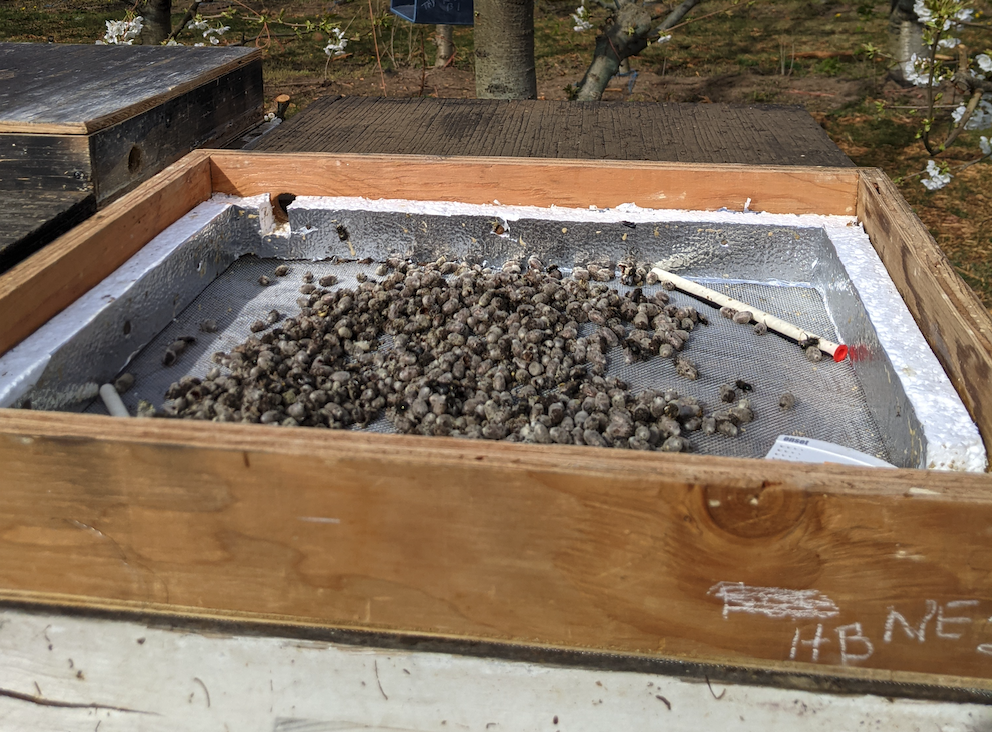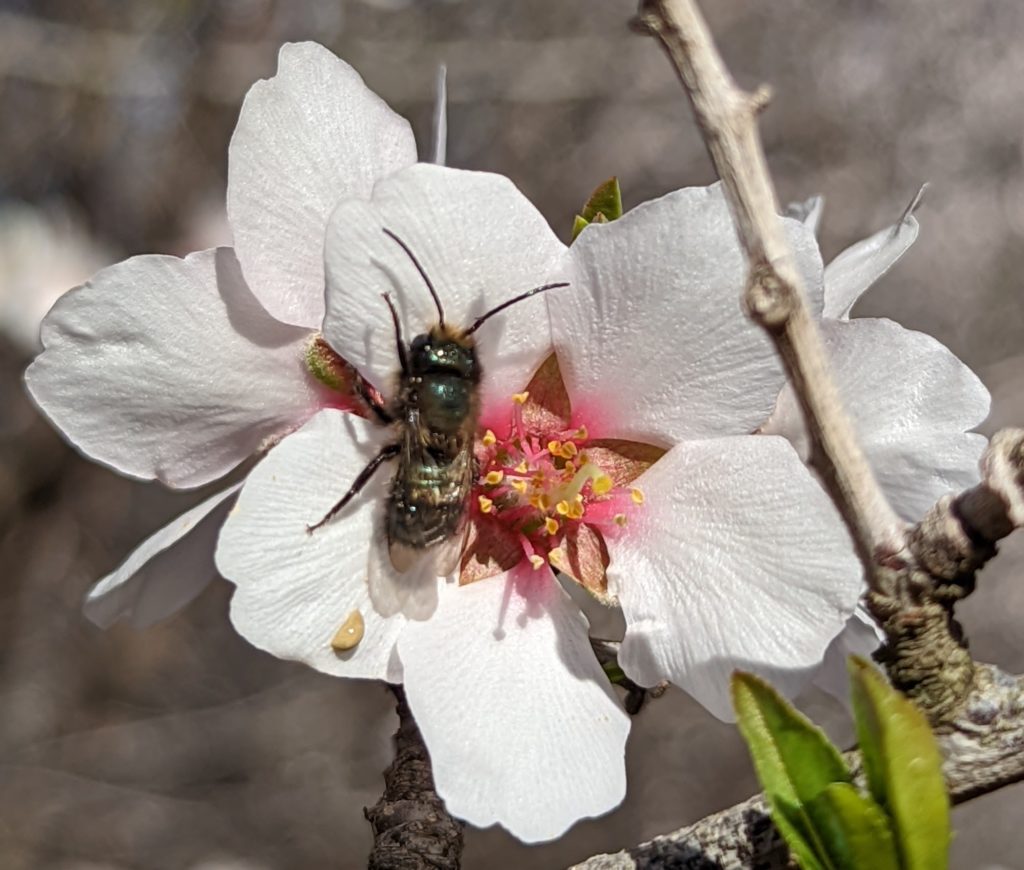
Jan/Feb 2023
The bees and the bees: Researching co-pollination
Honeybees have traditionally been used as pollinators, and have been adapted to agricultural systems throughout the world. Although they are often the first thing most people think of when they think of pollination, a combination of honeybee and native pollinators, such as the blue orchard bee, utilized through hive top incubators could be beneficial to the grower on several levels.
The blue orchard bee diversifies the pollination process because they have a whole different system of organization.
“Blue orchard bees are not like honeybees, in which they’re not social bees. They don’t make hives; they don’t have a caste system like honeybees do,” said Lindsie McCabe, research entomologist, USDA-ARS Pollinating Insects Research Unit. “They’re a solitary species. They nest in cavities.”
 Blue orchard bees don’t go through multiple generations per year — there’s one generation. The female lays its eggs, those eggs develop as larva and mature in the summer, and then they overwinter as adults in cocoons. Instead of a group of workers supporting a hive, they have to forage for food for themselves and their own brood.
Blue orchard bees don’t go through multiple generations per year — there’s one generation. The female lays its eggs, those eggs develop as larva and mature in the summer, and then they overwinter as adults in cocoons. Instead of a group of workers supporting a hive, they have to forage for food for themselves and their own brood.
“One of the benefits of blue orchard bees is that they are a very early spring bee. So, they’re found naturally in native environments, throughout the West. It’s important for them to get out and pollinate well before honeybees do, in cooler weather, often in poor conditions, such as rain. They are not afraid of rain,” said Diana Cox-Foster, research leader of the USDA-ARS Pollinating Insects Research Unit.
“I’ve seen this actually up in Washington, when they get really rainy seasons in the spring,” said McCabe. “The blue orchard bees will be out there, while the honeybees are just hunkered down and in their hives.”
They are especially useful in inclement weather and are often used as an insurance policy. In years where trees haven’t reached their carrying capacities, blue orchard bees help to increase yield.
While McCabe’s current research projects involve almonds, the same effect has been seen in cherry and pear orchards. The blue orchard bee is a sporadic pollinator, and can get a wider dispersion of pollen to different plants. It has also been observed that the introduction of the blue orchard bees has changed the behavior of the honeybees, but more research is needed and may be investigated further by USDA.
The hivetop incubators, which regulate heat for the honeybee hive, also allows for the controlled emergence of the bees to sync up with the almond bloom. And the process is fairly simple, as the blue orchard bee cocoons sit on top of the hive.
“The hivetop incubator is really beneficial for this,” McCabe said. “In our work, we’ve shown that the hivetop incubator is not detrimental to honeybee hives, it doesn’t remove the heat from the hives, and they grow. The colonies perform equally with or without hivetop incubators on them. But we did find that it emerges the bees up to six times faster. And this can really matter, especially in a crop like almonds, where you have these flash blooms.”
This research is detailed in their new publication, “Examination of Hivetop Incubator Efficacy for Emerging Osmia lignaria (Hymenoptera: Megachilidae) and the Impact on Apis mellifera (Hymenoptera: Apidae) Colonies” in Journal of Economic Entomology.
This type of bee has definitely grabbed the attention of growers. The suppliers of blue orchard bees have maxed out their supplies recently due to increased interest and awareness of the research. While some promising results have been found, further research is going to be done in the near future.
There is funding through the California Department of Food and Agriculture (CDFA) to continue testing until 2024. Part of that grant is understanding if the bees can adapt to their local environment. A benefit of having blue orchard bees that may make it more economical for growers, especially if a grower has 50% honeybees and 50% blue orchard bees, is that they get to keep those blue orchard bees, said McCabe. Those cocoons can be released the next year into the same orchards.
“Part of our CDFA-funded project is to understand if you keep releasing the same bees in the same orchard, or the progeny of the bees in the same orchard, are they going to be more acclimated to the climate in the orchard and do a better job pollinating or returning the progeny?” said McCabe.
Part of the next phase of research is looking at the return rate of the blue orchard bees, and a typical return in almond is between 30% – 60%. This return rate is weather dependent.
This past year, however, the orchards tested in the project returned fantastic numbers, with an average of 150%. So, for every 100 blue orchard bees that were released, 150 were returned.
“We also saw some really crazy returns that vary between 75% to almost 200% percent,” said McCabe.
Management of the blue orchard bee is pretty easy as well, as they like to nest in cavities. If growers would like to attract bees from a wild population, or keep released bees on their property, they could set up bee hotels using bundled reeds in an elevated box, or by simply drilling holes into wood. The holes should be 5/16 of an inch, and 6 inches long. Ideally, the holes should be 3/4 of an inch apart. It is important to clean these structures annually to prevent disease and parasites.
Extra flowers also help with the pollination, not only with blue orchard bees, but with honeybees as well. And there are some benefits that help the overall health of the orchard.
“I think a lot of the growers are finding benefit from those plantings, beyond just feeding the bees,” said Cox-Foster. “It’s providing a lot of benefit for soil conditioning, water retention, and excluding weeds surprisingly too.”
The synergetic use of honeybees and native pollinators, like the blue orchard bees, not only assists with the pollination and overall health of an orchard, but it could be more cost effective than traditional methods in the long run, and provide another opportunity for beekeepers. For a beekeeper to manage both bees, especially with the hivetop incubator, they could potentially make use of both and offer premier pollination services for growers.







